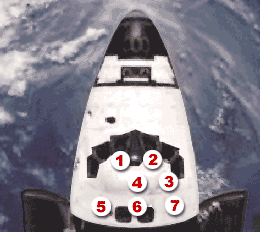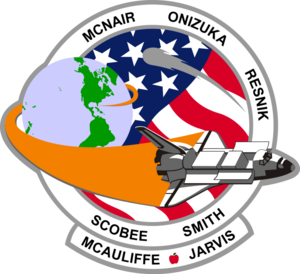STS-51-L facts for kids
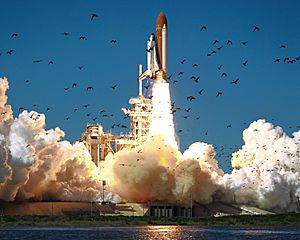
Challenger launches at the start of STS-51L
|
|
| Names | Space Transportation System-25 |
|---|---|
| Mission type | Satellite deployment |
| Operator | NASA |
| Mission duration | 6 days, 0 hour 34 minutes (planned) 1 minute 13 seconds (achieved) |
| Distance travelled | 29 km (18 mi) |
| Orbits completed | Failed to achieve orbit (96 planned) |
| Spacecraft properties | |
| Spacecraft | Space Shuttle Challenger |
| Launch mass | 1,217,990 kg (2,685,210 lb) |
| Landing mass | 90,584 kg (199,704 lb) (planned) |
| Payload mass | 21,937 kg (48,363 lb) |
| Crew | |
| Crew size | 7 |
| Members | |
| Start of mission | |
| Launch date | January 28, 1986, 11:38:00 am EST |
| Rocket | Space Shuttle Challenger |
| Launch site | Kennedy Space Center, LC-39B |
| Contractor | Rockwell International |
| End of mission | |
| Destroyed | January 28, 1986, 11:39:13 am EST |
| Landing date | February 3, 1986, 12:12:00 pm EST (planned) |
| Landing site | Kennedy Space Center, SLF Runway 33 (planned) |
| Orbital parameters | |
| Reference system | Geocentric orbit (planned) |
| Regime | Low Earth orbit |
| Perigee | 285 km (177 mi) |
| Apogee | 295 km (183 mi) |
| Inclination | 28.45° |
| Period | 90.40 minutes |
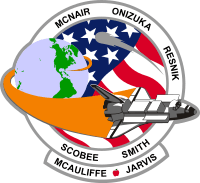 STS-51-L mission patch 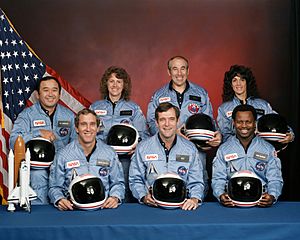 Back row: Ellison S. Onizuka, S. Christa McAuliffe, Gregory B. Jarvis, Judith A. Resnik Front row: Michael J. Smith, Francis R. "Dick" Scobee, Ronald E. McNair |
|
STS-51-L was the 25th flight of NASA's Space Shuttle program. This program aimed to make space travel routine for astronauts and cargo. STS-51-L was also the last flight of the Space Shuttle Challenger.
This mission was special because it was planned to be the first Teacher in Space Project. It also aimed to study Halley's Comet for six days. However, the mission never reached space. Just 73 seconds after launching from Kennedy Space Center Launch Complex 39B on January 28, 1986, the shuttle broke apart. All seven crew members died in this tragic event. They were Commander Francis R. "Dick" Scobee, Pilot Michael J. Smith, Mission Specialists Ellison S. Onizuka, Judith A. Resnik, and Ronald E. McNair. The Payload Specialists were Gregory B. Jarvis and S. Christa McAuliffe. The Challenger orbiter was also destroyed.
After the disaster, President Ronald Reagan created the Rogers Commission. This group investigated to find out why the explosion happened. They found that a rubber seal called an O-ring on the right Solid Rocket Booster (SRB) failed. This failure caused the shuttle to break apart during flight. All Space Shuttle flights were stopped while NASA fixed the problems. Shuttle missions started again in September 1988 with STS-26, about 32 months after the accident.
Contents
What Was the Mission's Plan?
The STS-51-L mission was the tenth flight for the Challenger shuttle. It had several important goals. One goal was to launch a new Tracking and Data Relay Satellite (TDRS-B). Another was to use a special tool called SPARTAN-203 to observe Halley's Comet. The mission also planned to have lessons taught from space as part of the Teacher in Space Project and the Shuttle Student Involvement Program (SSIP).
This flight was the first time American astronauts died during an orbital mission. It was also the first American human spaceflight that launched but failed to reach space. The first mission like this in the world was the Soviet Soyuz 18a mission, but its two crew members survived. Originally, Gregory Jarvis was supposed to fly on the mission before this one (STS-61-C). But he was moved to STS-51-L, and Congressman Clarence W. "Bill" Nelson took his place on the earlier flight.
Who Were the Astronauts?
The crew of STS-51-L included seven brave individuals.
| Position | Astronaut | |
|---|---|---|
| Commander | Francis R. "Dick" Scobee Would have been second spaceflight |
|
| Pilot | Michael J. Smith Would have been first spaceflight |
|
| Mission Specialist 1 | Ellison S. Onizuka Would have been second spaceflight |
|
| Mission Specialist 2 | Judith A. Resnik Would have been second spaceflight |
|
| Mission Specialist 3 | Ronald E. McNair Would have been second spaceflight |
|
| Payload Specialist 1 | Gregory B. Jarvis Would have been first spaceflight Hughes Space and Communications |
|
| Payload Specialist 2 | S. Christa McAuliffe Would have been first spaceflight Teacher in Space Project |
|
Backup Crew Members
Sometimes, backup crew members are chosen in case someone from the main crew cannot fly. For this mission, there were two backup specialists.
| Position | Astronaut | |
|---|---|---|
| Payload Specialist 1 | L. William Butterworth Would have been first spaceflight Hughes Space and Communications |
|
| Payload Specialist 2 | Barbara R. Morgan Would have been first spaceflight Teacher in Space Project |
|
| Barbara Morgan later became a NASA astronaut in 1998. She flew on STS-118 in 2007 as a mission specialist. | ||
Where Did the Crew Sit?
The table below shows where each astronaut would have sat during launch and landing. Seats 1-4 were on the Flight Deck, which is like the cockpit. Seats 5-7 were on the Middeck, a lower area.
| Seat | Launch | Landing |
Seats 1–4 are on the Flight Deck. Seats 5–7 are on the Middeck. |
|---|---|---|---|
| S1 | Scobee | Scobee | |
| S2 | Smith | Smith | |
| S3 | Onizuka | McNair | |
| S4 | Resnik | Resnik | |
| S5 | McNair | Onizuka | |
| S6 | Jarvis | Jarvis | |
| S7 | McAuliffe | McAuliffe |
Even though the crew died in the Challenger disaster, this chart shows their planned seating if the mission had gone as expected.
What Caused the Disaster?
During the launch, 73 seconds after liftoff, the shuttle broke apart. The Rogers Commission later found that the main reason for the accident was a problem with the O-ring seals. These seals were on the right Solid Rocket Booster (SRB) of the Challenger.
These seals failed, allowing hot gases to escape. This hot gas acted like a flamethrower, burning through a support strut that held the booster in place. When this strut failed, the booster moved freely. The front part of the booster then hit the main fuel tank. This caused the fuel tank to break apart.
When the fuel tank broke, its propellants (fuel and oxidizer) quickly burned. With the main structure of the shuttle damaged, the SRBs flew off on their own. The orbiter itself also broke apart very quickly due to strong air forces.
The launch had been approved even though the temperature was very cold, about −3 °C (27 °F). This was much colder than the temperature the SRBs were designed for, which was above 4 °C (39 °F).
Investigators found that some of the emergency air packs (PEAPs) carried by the astronauts had been turned on. This suggests that some crew members were alive and able to act for a short time after the shuttle broke apart. However, the exact cause of death for the astronauts was not officially determined.
Mission Goals and Experiments
The STS-51-L mission had several important scientific and educational goals:
- Launching the Tracking Data Relay Satellite-B (TDRS-B) with a booster.
- Flying the "Shuttle Pointed Autonomous Research Tool for Astronomy" (SPARTAN-203) to study Halley's Comet.
- Conducting the Fluid Dynamics Experiment (FDE).
- Running the Comet Halley Active Monitoring Program (CHAMP).
- Performing the Phase Partitioning Experiment (PPE).
- Carrying out three experiments from the Shuttle Student Involvement Program (SSIP).
- Delivering two lessons for the Teacher in Space Project (TISP).
- (Unofficial) Astronaut Ronald E. McNair planned to play the saxophone in space for a song on Jean-Michel Jarre's album, "Rendez-Vous".
Launch Delays
The launch of STS-51-L was delayed several times before the final attempt.
- January 22, 1986: Rescheduled due to delays with the previous shuttle flight, STS-61-C.
- January 23, 1986: Rescheduled again because of delays with STS-61-C.
- January 24, 1986: Scrubbed (cancelled for the day) due to bad weather at the emergency landing site across the Atlantic.
- January 25, 1986: Scrubbed because of delays in getting the shuttle ready for launch.
- January 27, 1986: Scrubbed due to equipment problems inside the orbiter and strong crosswinds at the shuttle landing site.
- January 28, 1986, 9:37 am: Delayed due to technical issues with a fire detection system.
- January 28, 1986, 11:38 am: The final launch attempt, which resulted in the loss of the vehicle and crew.
Mission Patch
Francis R. "Dick" Scobee, the mission commander, asked an engineer named Ernie Reyes to design the mission patch. This patch shows the Challenger launching from Florida and flying into space. The patch highlights the many goals of the mission.
The seven stars on the patch represent the seven crew members. The patch also shows Halley's Comet against the background of the U.S. flag. The names of the crew members are written around the edge. Christa McAuliffe, the first teacher in space, has a symbolic apple next to her name.
Images for kids
See also
 In Spanish: STS-51-L para niños
In Spanish: STS-51-L para niños


